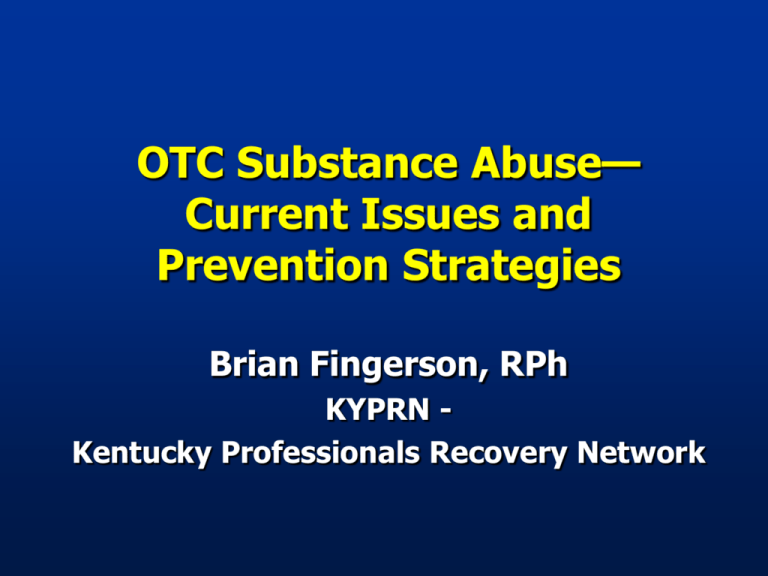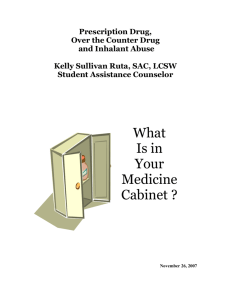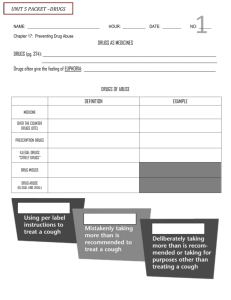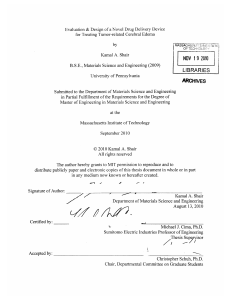OTC Substance Abuse and The Adolescent Brain
advertisement

OTC Substance Abuse— Current Issues and Prevention Strategies Brian Fingerson, RPh KYPRN Kentucky Professionals Recovery Network There is a unique disconnect between the scientific facts and the public’s perception about drug abuse and addiction Drug abuse is a preventable behavior Drug addiction is a treatable disease Partnership for a Drug-Free America http://www.drugfree.org/ Initial drug use is a voluntary behavior… A person chooses to take a drug for the first time Why do people take drugs in the first place? People Take Drugs To: Feel good (sensation seeking) Feel better (self-medication) A major reason people take a drug is they like what it does to their brains Prolonged drug use changes the brain in fundamental and long-lasting ways Addiction is a Developmental Disease—Typically Begins in Childhood or Adolescence Five Things to Know About Adolescents’ Brain Development and Use Thomas J. Crowley, MD, and Elizabeth Whitmore, PhD http://www.hbo.com/addiction/ Five Things to Know About Adolescents’ Brain Development and Use 1. The brain’s “front end,” the part above the eyes (prefrontal cortex), exists to slow us down or stop our impulsive behaviors; it considers the risks and benefits of our actions, and it helps us "hit the brakes" when we consider doing things that are too risky. 2. This part of the brain is still developing connections to the rest of the brain until adulthood, so adolescents’ brains lack some of the “wiring” that carries “brake” or “stop” messages to the rest of the brain. http://www.hbo.com/addiction/ Five Things to Know About Adolescents’ Brain Development and Use 3. Drugs of abuse are often available to adolescents; these drugs feel good, but they can be very harmful. Lacking some of the wiring for the "stop" message, adolescents’ brains may not fully weigh the risks of drug use. (if it feels good – do it ) 4. The two drugs that cause the most death are also the most available drugs: tobacco and alcohol. Late adolescence, before the brain is fully matured, is the peak time for developing dependence on these (and other) drugs. http://www.hbo.com/addiction/ Five Things to Know About Adolescents’ Brain Development and Use 5. Heavy drug use during times of critical brain development may cause permanent changes in the way the brain works and responds to rewards and consequences. Therefore, it is important to begin to address a developing substance use problem as early as possible. http://www.hbo.com/addiction/ Over-the-Counter Drug Abuse OTC drugs, especially cough and cold medications, are becoming very popular as recreational drugs Especially for young teenagers 13 to 16 years of age Hospitals have reported dozens of overdoses in the past 2 years Including five deaths where the abuse of OTC medications was a factor Emergency Departments 2005 An estimated 598,542 U.S. ED visits in 2005 involved the nonmedical use of prescription or OTC pharmaceuticals or dietary supplements 21% higher than 2004 estimates from the SAMHSA 2006 National Survey on Drug Use and Health (NSDUH) In 2006, about 3.1 million persons aged 12 to 25 (5.3 percent) had ever used an over-the-counter (OTC) cough and cold medication to get high (i.e., “misused” the drug), and nearly 1 million (1.7 percent) had done so in the past year Among youths aged 12 to 17, females were more likely than males to have misused OTC cough and cold medications in the past year, but among young adults aged 18 to 25, males were more likely than females to have misused these medications Among persons aged 12 to 25 who had misused an OTC cough and cold medication in the past year, 30.5 percent misused a NyQuil® product, 18.1 percent misused a Coricidin® product, and 17.8 percent misused a Robitussin® product Erowid Psychoactive Vaults www.erowid.org Erowid’s Site Oral DXM Dosages Threshold Unknown Light 100–200 mg Common 200–400 mg Strong 300–600 mg Heavy 600–1,500 mg Risk of Death 2,500–20,000 mg http://www.erowid.org Erowid Guide to DXM in Nonprescription Drugs Version 1.6 — June 15, 2004 93 products and ingredients listed for DXM products only Erowid’s Guide Introduction For those who choose to use DXM recreationally, it is extremely important to pay attention to the active ingredients list of the brand they choose to use. People knowledgeable in the field recommend that only products containing DXM alone (sometimes listed as 'Dextromethorphan hydrobromide') in the Active Ingredients list should be used. http://www.erowid.org Gel Cap Dosages Drixoral Cough Liquid Caps© – 30 mg DexAlone© – 30 mg Robitussin Cough Gels© – 15 mg Cough Syrups OTC DXM content ranges from 7.5 mg per 5 ml to 15mg per 5 ml, so…a 240ml bottle would be 360-720mg of DXM Triple C’s or Coricidin Cough and Cold© Contains: Chlorpheniramine maleate 4 mg Dextromethorphan hydrobromide 30 mg Other Coricidin products contain acetaminophen and/or guaifenesin “This product should not be used as a source for recreational DXM”— Erowid DXM Plateaus A term used by those who abuse DXM Describes experiences associated with different recreational dosages (exceeding recommended dosages) Experiences at different plateaus range from mild distortions of color and sound to visual hallucinations, “out-of-body” dissociative sensations, and loss of motor control The third plateau is what many DXM users strive for, often described as the most “mindopening” http://www.third-plateau.org DXM Effects Positive Mood lift, euphoria Giggling, laughing Dissociation of mind from body (positive when sought) Visual and aural hallucinations (positive when sought) Creative dreamlike experiences Some users report empathic feelings, forgiveness, warm feelings toward others DXM Effects Neutral Pupil dilation Confusion, disorientation Skin sensitivity, alters tactile (touch) and skin sensations Robotic, zombie-like walking, "robo-walk" Discoordination, reduced agility DXM Effects Negative Upset stomach, vomiting Dizziness Decreased sexual functioning (difficulty achieving orgasm) Body itching Rash, red blotchy skin Diarrhea Fever Tachycardia (racing, pounding heart) Some users report feeling disconnected, isolated from others Some users report hangover/depression on the following 1-2 days Restricting DXM Sales Oklahoma considering a bill that would ban the sale of any cough medicine containing DXM, as well as spray paint, to anyone under the age of 18 years New York, other states, considering similar legislation Throughout the country Some stores require ID showing the purchaser is at least 18 years of age Some place DXM products behind-the-counter Inhalant Abuse: Definition Commonly known among kids as "huffing," "bagging," or "sniffing" The deliberate concentration and inhalation of common products found in homes, offices, and schools to get high Inhalant Abuse: Statistics National surveys of young people and U.S. households indicate that: Among high school students, inhalants are 5th most-abused substance after alcohol, tobacco, marijuana, and prescription drugs Almost as many 8th graders have ever tried inhalants (16%) as have tried marijuana (18%), according to Monitoring the Future 2003 According to the 2002 Household Survey, 308,000 teens, aged 12–17 used inhalants in the past month Fewer than 1 in 20 parents believe their children may have ever abused inhalants (denial or ignorance?) Why Do Young People Abuse Inhalants? Products are legal, widely available, inexpensive, and easy to conceal Most users do not realize how dangerous inhalants are Many young people start because they don't think these substances can hurt them >1,000 Common Products Are Potential Inhalants That Can Kill Glue Freon Correction fluid Computer agents Deodorizers Markers Paint products Gases (whippets, butane, propane) Gasoline Fire extinguishers Nail polish remover Lighter fluid Hair spray Cleaning agents Inhalant Abuse: Harmful Effects Chronic inhalant users can suffer severe and permanent brain damage; some die the first time they experiment Other possible risks include: Intoxication Hearing loss Bone marrow damage Short-term memory loss Limb spasms Liver and kidney damage Laxatives Laxative abuse is a common feature of eating disorders Although it is a behavior associated with bulimia, many anorectics and even over-eaters use or occasionally use laxatives Laxative Abuse Problems Severe abdominal pain Chronic diarrhea/loss of rectum control after repeated use of laxatives Bloating Dehydration Gas Nausea, vomiting Electrolyte disturbances which can lead to heart arrythmias and heart attacks Chronic constipation What Are Energy Drinks? Contain large doses of caffeine and other legal stimulants Beverages such as Red Bull, Venom, Adrenaline Rush, 180, ISO Sprint, and Whoop Ass Other Energy Drink Ingredients B vitamins Ephedra Glucuronolactone Ginseng Green tea Guarana Inositol L-tyrosine Sugar Taurine Yohimbine Various others “The Legal Alternative”? http://www.drinkcocaine.com Caffeine Content of Cocaine Energy Drink© An 8.4 oz can of Cocaine Energy Drink contains 280 mg of caffeine Cocaine is a new energy drink from Redux Beverages Available in an 8.4 oz (250 mL) can, the drink claims that it is 350% stronger than a Red Bull FDA Action Warning letter issued April 4, 2007 Claims Cocaine energy drink is marketed as a dietary supplement “Street drug alternatives, i.e., products that claim to mimic the effects of recreational drugs, are not intended to supplement the diet and, as a result, cannot lawfully be marketed as dietary supplements.” FDA states that Cocaine energy drink is a new drug requiring an application to the FDA http://www.fda.gov/foi/warning_letters/b6312d.htm Redux Beverages LLC Response Language that FDA cited removed from Web site New information states: “Cocaine energy drink is an energy supplement following the guidelines set forth by the federal Food and Drug Administration for dietary supplements… It is not designed for or intended to be used to diagnose, treat, cure, mitigate, or prevent any diseases.” http://www.drinkcocaine.com April 23, 2007. And now: ‘Cocaine’ drink yanked from shelves nationwide Company plans to rebrand the energy beverage after FDA complaints Here is the latest 'Cocaine' energy drink renamed as 'Censored' The makers of the energy drink "Cocaine" have announced that they will be changing the name in response to criticism and pressure from the FDA and state officials saying the name glamorized illegal drug use. So, appropriately, the new name will be "Censored," because it has the "same rebellious and fun spirit" as the old name. Caffeine Doses Oral Caffeine Dosages Threshold 10–20 mg Common 50–150 mg Strong 150–400 mg Heavy 400+ mg Lethal 3–20 g oral (estimated, see below) LD50 (lethal dose) 192 mg/kg in rats Onset : 5–10 minutes Duration: 1.5–5 hours Normal after effects: up to 24 hours Caffeine Effects: Positive Reduces boredom (Loke 1988) Decreases depression Increased alertness when tired (Wesenten 2005, Kamimori 2005) Willingness to consider alternative theories (Martin 2006) Increases physical stamina and reduces perceived exertion (McLellan TM 2004) May attenuate the response-slowing effect of alcohol (Roehrs 2004) Increases performance on boring, repetitive tasks (Smith 2002) Caffeine Effects: Neutral Research has failed to show improved memory or improvement in complex cognitive tasks Smith A. Food Chem Toxicol. 2002;40:1243–55. Caffeine Effects: Negative Increases anxiety and nervousness at high doses or in sensitive individuals (Loke 1988) Insomnia, decreased ability to sleep (Smith 2002) Caffeine withdrawal can worsen mood (Schuh 1997) Caffeine withdrawal causes headaches, flu-like symptoms, feelings of lethargy and reduces motivation (Schuh 1997) Increases jaw tension and bruxism (Erowid Self Reports 2000, Ohayon 2001) Ephedra/Ephedrine/ Pseudoephedrine Ephedra is used as a stimulant and for mild respiratory disorders, including asthma and bronchitis In Asian medicine, it is used for fever, swelling, and bone pain Ephedrine, the principle alkaloid, a popular ingredient in many "herbal" weight loss and body building formulas, decongestants, "legal high" alternatives, and ephedrinebased pep pills Negative Effects of Ephedra Potential side effects include sleeplessness, restlessness, irritability, headache, nausea, vomiting, urinary disorders, and rapid heartbeat Higher doses can stimulate a sharp rise in blood pressure and disrupt heart rhythm Chronic use can lead to tolerance and dependence, requiring ever larger doses to obtain earlier effects Because of these dangers, ephedra should be used only for short periods of time Salvia divinorum Effects Positive Short duration (when smoked) Radical perspective shifting Increase in sensual and aesthetic appreciation Creative dreamlike experience Insight into personal issues http://www.erowid.org Salvia divinorum Effects Neutral Powerful open and closed eye visuals General change in consciousness (as with most psychoactives) Altered perceptions Change in body temperature, flushing Sensation of physical push, pressure, or wind Sensation of entering or perceiving other dimensions, alternate realities Feeling of 'presence' or entity contact Dissociation at high doses, walking, or standing http://www.erowid.org Salvia divinorum Effects Negative Overly intense experiences Fear, terror, and panic Increased perspiration Possible difficulty integrating experiences Higher doses can cause inability to control muscles and maintain balance; falls are reported http://www.erowid.org Posting on You Tube Salvia Divinorum Short student documentary about Salvia Divinorum...salvia divinorum documentary salvia divinorum documentary Time: 07:59 Salvia an “Outlaw Drug” It has been put into DEA Schedule I in a number of states - effective 1 Jan. ‘08 it is Schedule I in Illinois Erowid keeps users abreast of what is legal or illegal based on location Many Other Legal Alternatives http://www.drugabuse.gov For More Information National Institute on Drug Abuse Public Information Office 301-443-1124 or http://www.nida.nih.gov http://www.drugabuse.gov National Clearinghouse on Alcohol and Drug Information http://ncadi.samhsa.gov 800-729-6686 Online Resources http://www.erowid.org http://www.third-plateau.org http://www.usaprn.org http://family.samhsa.gov http://ncadi.samhsa.gov http://www.casacolumbia.org Take Home Messages Drug abuse is a preventable behavior and drug addiction is a treatable disease. Addiction is a developmental disease typically beginning in childhood or adolescence. Children and adolescents have access to information on misuse and abuse of substances that are widely available and legal to obtain. Thank you! “Recovery” by Michael Vye Brian Fingerson, RPh KYPRN 502-749-8385 kyprn@insightbb.com How Prevalent Is Cough Medicine Abuse? Nearly 1 in 10 teens (or 2.4 million) reported abusing cough medicine to get high in 2005 Partnership for a Drug-Free America http://www.drugfree.org Partnership Attitude Tracking Study What Can Pharmacists Do? Be aware of the issues Provide education regarding the potential abuse and misuse of medications and other products Evaluate product placement in the pharmacy Be aware of suspect purchases Provide education to parents and community groups What Can Faculty Do? Prepare students to address this issue when they enter practice Awareness Educational strategies Role plays Develop fact sheets Public service announcements Others





